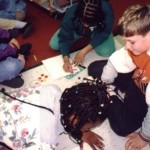“We learn more by looking for the answer to a question and not finding it than we do from learning the answer itself.” -Lloyd Alexander

“I never teach my pupils; I only attempt to provide the conditions in which they can learn.” -Albert Einstein
I was never more aware of how important hands-on instruction is until I taught concepts like decimals. Many students have responded to decimals in ways that surprised me.
A few years ago, I was working with a junior high to help the 7th grade math teachers understand how to better use small groups and differentiated instruction. One class was learning about conversions of fractions, decimals, and percents in problem solving situations. As I circulated amongst the students during independent work time, I stopped at one desk. The student, who had been the most belligerent during the teacher-directed instruction, was struggling with the following problem:
Larry has a closet full of shoes. He has some brown ones and some black ones. If ¾ of Larry’s shoes are brown, what percentage of the shoes is brown?
The student had written at least five different equations out beside the problem, but wasn’t arriving at any of the possible answers. I asked her if she’d ever thought about fractions, decimals, and percents in terms of money. She got a puzzled look on her face and asked me what I meant.
I pulled a quarter out of my pocket and asked her how much the coin was worth. When she responded that it was worth 25¢, then I placed four quarters on the desk and asked her how much those coins were worth. We discussed how four quarters equaled 100¢. I asked her if she saw any relationship between 100 cents and 100 percent. I drew a circle and asked her if her teacher had used a circle to explain percents. The student nodded yes. I then divided the circle into 4 equal parts, and shaded 3 of the parts.
Next, I stacked up three of the quarters beside the circle and asked her what fractional part of the set was represented by the quarters in the stack. She said ¾. I pointed to the shaded circle and the stack and asked her if they looked alike. I asked her how many cents were in the stack. She said 75. I asked her to think if there was any connection between fractions, money, and percents based upon what was on her desk.
Then, I did what is sometimes really challenging for a teacher to do…I waited and gave her time to use deductive reasoning.
After a minute, she laughed and said, “The 3 quarters are ¾ of a dollar. A dollar is worth 100 cents just like 100 percent. So, if I have 3 quarters I have 75¢ which is the same as 75%. You mean I could have been using money all along to figure out decimals and percents? Isn’t that cheating?”
I explained to her that it wasn’t cheating. It was relating all of it to something she knew about…money! I know this may sound silly, but many times we fail to help students make this type of connection. Pointing out the use of decimals in monetary amounts gets their attention and helps the student make a connection to their world. Some students never realize that decimals, fractions, and percentages are three ways of relating the same value.
The following offer valuable information as you prepare to help students truly understand what a decimal is and how simple conversions can be. Each link provides good questions for use during Tabor Rotation Teacher Time and the Whole-Group Mini-Lesson.
“Another Look at Decimals and Percent,” by Lola May, Teaching PreK-8, April 2000. [http://findarticles.com/p/articles/mi_qa3666/is_200004/ai_n8898042/]
Mrs. Glosser’s Math Goodies, “The Decimal Dance” and “Repeating Decimals and the Monster That Wouldn’t Die.” [http://www.mathgoodies.com/articles/creative_ideas.html]
Of course, coolmath.com has an amazing number of high quality lessons about decimals in their pre-algebra section.
Remember,
“It’s not what is poured into a student that counts, but what is planted.” -Linda Conway“A mind is a fire to be kindled, not a vessel to be filled.” -Plutarch
If this blog didn’t inspire you to think about doing something meaningful with decimals, then maybe the next quote will provide a little chuckle…
“If a doctor, lawyer, or dentist had 40 people in his office at one time, all of whom had different needs, and some of whom didn’t want to be there and were causing trouble, and the doctor, lawyer, or dentist, without assistance, had to treat them all with professional excellence for nine months, then he might have some conception of the classroom teacher’s job.” -Donald D. Quinn
Have a great weekend, everyone! See you on Monday for more inspiration!

